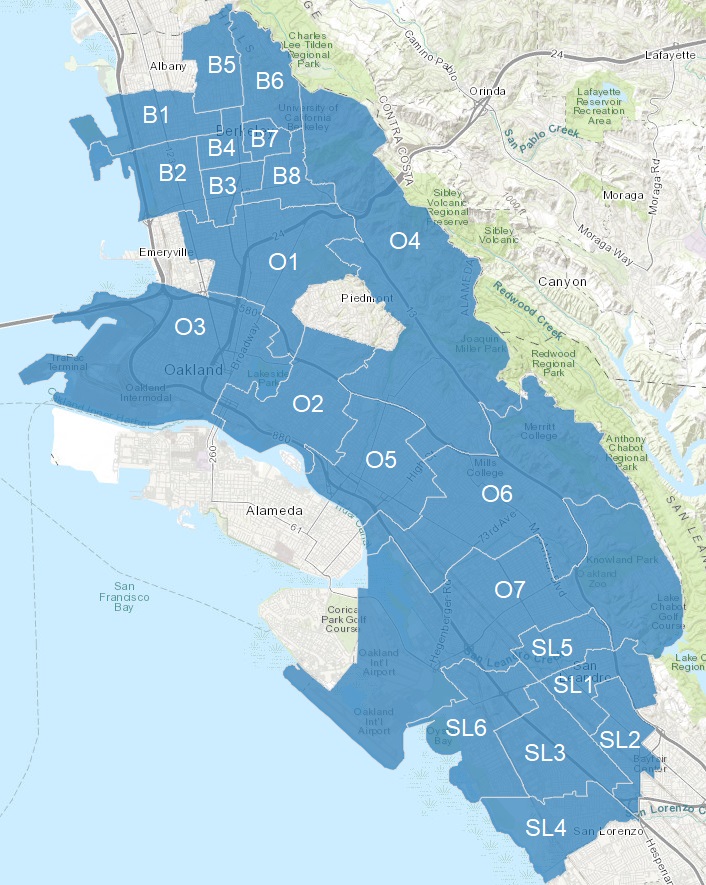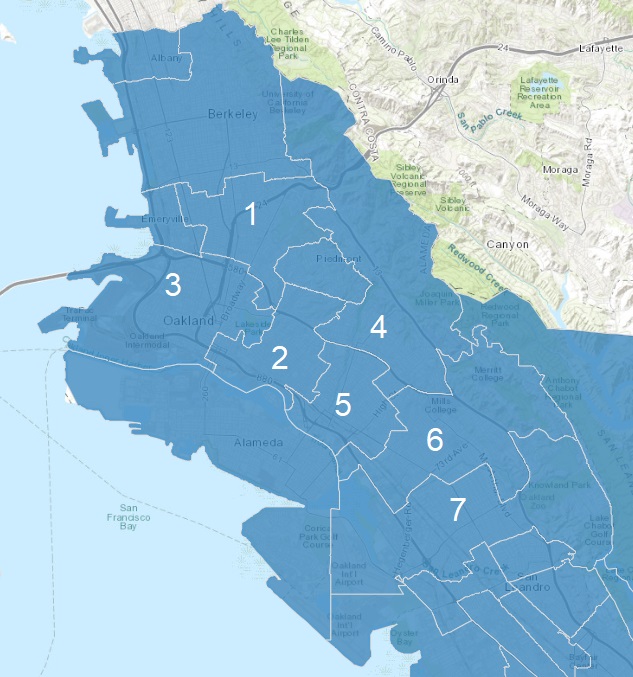Since 2010, the cities of Oakland, Berkeley, and San Leandro have joined San Francisco in the use of an instant runoff process to elect its mayor and council members. This way, voters rank their choices on one ballot, rather than vote for one candidate in one election and then another in a separate runoff election. In 2022, Albany adopted at-large multi-winner ranked-choice voting to address a voting rights legal challenge without dividing the already small city into districts. Here, you can see results for those contests with more than one round, and try Ranked Choice practice polls.
| Candidate | 1st choice | 2nd choice | 3rd choice |
|---|---|---|---|
| Lou |  |
 |
 |
| Bob |  |
 |
 |
| Kim |  |
 |
 |
Your vote will count for your highest-ranked candidate,
but some candidates
may be eliminated.

|
|||||
| Kim |
|
||||
| Lou |
|
||||
| Bob |
|

|
||||||
| Kim |
|
|||||
| Lou |
|
In this count, because Bob was eliminated, your vote counted for Kim, your second choice.
Oakland's April 15, 2025 special election for mayor and District 2 councilmember
Oakland's special election filled the mayor's office vacated by the November 2024 recall of Sheng Thao, and filled the council district 2 seat vacated by Nikki Fortunato Bas, who was elected to the Alameda County Board of Supervisors, replacing the retiring Keith Carson, a leading supporter of ranked-choice voting and proportional representation.
Former congresswoman and longtime RCV supporter Barbara Lee won in the first round of the mayoral contest, as determined by the county, with Loren Taylor in a strong second-place position, as he was in the November 2022 mayoral contest. However, Lee maintains a decisive lead even if other candidates are eliminated. The county omits invalid write-in votes from its count, and about a dozen votes in small precincts were redacted from the county's data, so the DemoChoice results are slightly different.
Charlene Wang wins the contest for council district 2 in a few rounds, always maintaining a strong lead. The percentage of voters who incorrectly marked any ranking column with more than one candidate decreased from 5% in the November 2024 at-large council contest to 1% in the 2025 contests, likely due to improved instructions on the ballot and in the voter guide. In 2025 the number who ranked a column and left a higher column blank was a bit under 1% and the number who defied the instructions and ranked the same candidate more than once was 3% for District 2 and 4% for mayor. The blank or repeated rankings are innocuous if a voter has expressed all preferences, but could indicate either a confused or a creative voter.
| April 2025 Results | Results | Stats | ||
| 2025 Oakland Mayor |
 |
 |
 |
|
| 2025 Oakland City Council, District 2 |
 |
 |
 |
|
In April 2025, Oakland continued to use a ballot with only 5 ranking columns even though there were more candidates in both contests and San Francisco demonstrated the well known fact that the ballot and voting equipment can accommodate more columns. The ballot had a very large empty space between the candidate names and the ranking columns. This issue was tangled in a lawsuit brought by the Alameda County Taxpayers Association that was resolved at the May 6 city council meeting, at which the council agreed to pursue more rankings in the future.
The November 2024 results are from the Dec 3 cast vote record (CVR) release. This may be the final certified data, but the Registrar of Voters has not confirmed this. For this election, the county released preliminary cast vote records as votes were being counted. In the past, cast vote records were not released until after final certification. In an apparent attempt to comply with Elections Code 15250.5 and a memo from the Secretary of State, the Registrar of Voters omitted ballots from precincts with less then 10 votes cast.
So, in the November 2024 results below, two precincts in Oakland were omitted. This has caused 8 missing votes in the Oakland at-large contest and 2 missing votes from the Oakland District 7 contest. One omitted precinct is the Oakland Airport, which is in Oakland city limits, but is in the San Leandro school district, as can be seen on the maps below. The other is near the small boot-shaped appendage of Redwood Regional Park along Oakland city limits. The Eden Health District, which provides services to Hayward and nearby unincorporated areas, has an appendage in its District 3 that extends through unpopulated wilderness to cross into Oakland. These create unique combinations of contests on the ballots where the jurisdictions overlap, requiring separate precincts.
While Elections Code 15250.5 applies only to posting of results on election night, the Registrar is also omitting votes from the final certified Statement of Vote and CVRs, which seems inconsistent with Elections Code 15372-15374.
In November 2022, there was a mixup in the settings when the Registrar tallied that election, regarding ballots with a blank first choice but valid lower choices. This led to a court-ordered change in a certified election result for Oakland school director district 4, and a close call in San Leandro council district 5. By late 2024, this has still not been fully clarified in the county's posted results. Also, the 2018 and 2020 RCV results are not posted on the Registrar's website, but you can find an unofficial interpretation of those results below.
There is ongoing community advocacy for more ranking columns. If there are not as many ranking columns as candidates (or actually that minus one) people can use all of the columns and still not have their vote count in the final round. In November 2024, the Oakland at-large contest had 10 candidates, but only 5 ranking columns were provided. Oakland's charter 1105(k)(1) allows fewer rankings than candidates only if "the voting equipment cannot feasibly accommodate" the same number of rankings. Meanwhile, San Francisco provided 10 ranking columns in its 13-candidate mayoral contest using the same voting equipment. The stats page shows that 3341 voters (2.3%) used all 5 rankings but still exhausted. Surely many of them would have made use of additional columns, and then would have been more likely to have their vote counted in the final round. In Oakland's 10-candidate mayoral election in 2022, the number of these involuntarily exhausted ballots exceeds the margin of victory. Those ballots would have had to vote overwhelmingly for the second-place candidate to change the winner, but this was another case where more ranking columns should have been available.
There are about 17 ranked-choice contests held every two years in Alameda County.
The contests that are not shown here had a first-round winner.
In the 42 multi-round contests between 2010 and 2022, there were 1,347,680 votes that counted in at least the first
round.
The results shown here are an independent, unofficial analysis of cast vote records released by the county. Some
results differ slightly from those published by the county. In some
instances, if a ballot's first choice is blank or for an invalid
write-in, but also has lower choices other than an invalid write-in, the county calls it a "suspended" ballot and does not count it
until round 2.
In some years, the 'exhausted ballots' in the results published by the county include those of voters who did not
cast a vote at all in the
ranked-choice contest, but voted in other contests such as president or senator.
The results released by the county separate out all "overvotes" (more than one vote
in the same column), whereas the DemoChoice software treats them as votes for "none of
these". Ballots with first-round overvotes are ignored in the results shown here.
In some single-winner contests, the county has continued eliminations until only one candidate remains.
DemoChoice eliminates all but winners in multi-winner contests, but not single-winner contests.
** indicates contests where a winner overcame a leading first-round candidate in later rounds.
* indicates single-winner contests where a candidate who was not one of the top two in the first round was in the top two in the final round.



